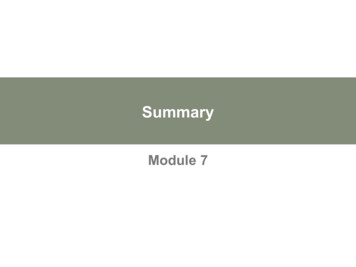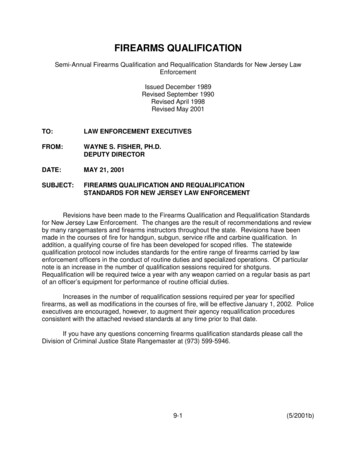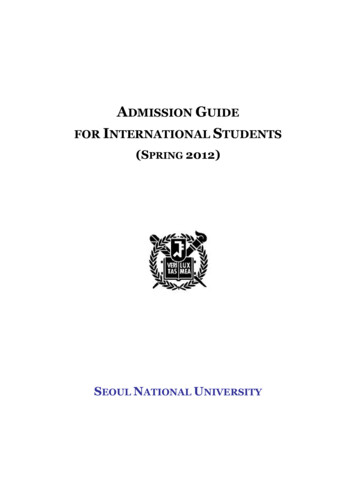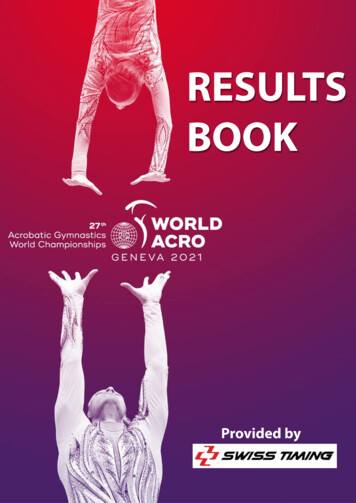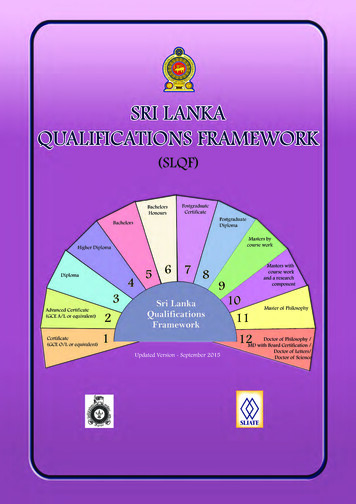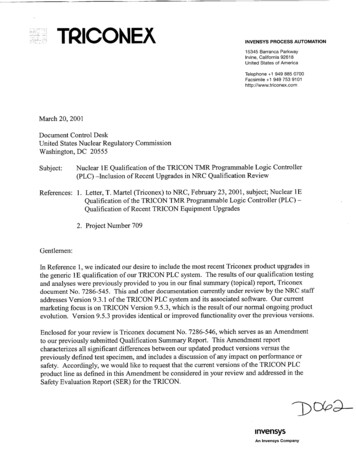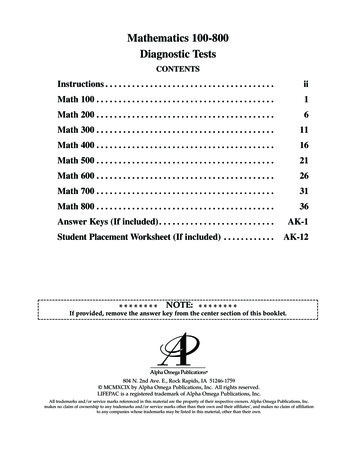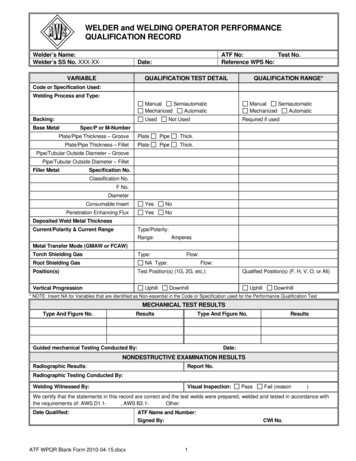
Transcription
National DéfenseDefence nationaleA-CR-CCP-805/PG-001ROYAL CANADIAN AIR CADETSPROFICIENCY LEVEL FIVEQUALIFICATION STANDARD AND PLAN(ENGLISH)(Supersedes A-CR-CCP-805/PG-001 dated 2010-10-01)Cette publication est disponible en français sous le numéro A-CR-CCP-805/PG-002.Issued on Authority of the Chief of the Defence StaffCanada
National DéfenseDefence nationaleA-CR-CCP-805/PG-001ROYAL CANADIAN AIR CADETSPROFICIENCY LEVEL FIVEQUALIFICATION STANDARD AND PLAN(ENGLISH)(Supersedes A-CR-CCP-805/PG-001 dated 2010-10-01)Cette publication est disponible en français sous le numéro A-CR-CCP-805/PG-002.Issued on Authority of the Chief of the Defence StaffOPI: D Cdts & JCR 4 – Senior Staff Officer Youth ProgramsDevelopmentCanada2015-07-01
A-CR-CCP-805/PG-001LIST OF EFFECTIVE PAGESInsert latest changed pages and dispose of superseded pages in accordance with applicable orders.NOTEThe portion of the text affected by the latest change is indicated by a black vertical linein the margin of the page. Changes to illustrations are indicated by miniature pointinghands or black vertical lines.Dates of issue for original and changed pages are:Original. 0 . 2015-07-01 Ch. 3 .Ch. 1 . Ch. 4 .Ch. 2 . Ch. 5 .Zero in Change No. column indicates an original page. Total number of pages in this publication is 179consisting of the following:Page No.Change No.Cover page.0Title.0A to C.0i to vi. 01-1 to 1-4. 02-1 to 2-6. 02A-1 to 2A-2.02B-1 to 2B-2.02C-1 to 2C-6. 03-1 to 3-6. 03A-1 to 3A-2.03B-1 to 3B-2.03B1-1 to 3B1-4.03B2-1 to 3B2-12.03B3-1 to 3B3-2.03B4-1 to 3B4-8.03B5-1 to 3B5-4.03B6-1 to 3B6-4.03C-1 to 3C-2. 03D-1 to 3D-2. 03D1-1 to 3D1-4. 03E-1 to 3E-2.03E1-1 to 3E1-2.04-1-1 to 4-1-2. 04-501-1 to 4-501-2. 04-C501.01-1 to 4-C501.01-2. 04-C501.02-1 to 4-C501.02-2. 0Page No.Change No.4-C501.03-1 to 4-C501.03-2. 04-502-1 to 4-502-2. 04-M502.01-1 to 4-M502.01-4. 04-503-1 to 4-503-2. 04-M503.01-1 to 4-M503.01-4. 04-M503.02-1 to 4-M503.02-4. 04-M503.03-1 to 4-M503.03-2. 04-M503.04-1 to 4-M503.04-2. 04-C503.01-1 to 4-C503.01-2. 04-504-1 to 4-504-2. 04-M504.01-1 to 4-M504.01-4. 04-C504.01-1 to 4-C504.01-2. 04-507-1 to 4-507-2. 04-M507.01-1 to 4-M507.01-4. 04-C507.01-1 to 4-C507.01-2. 04-C507.02-1 to 4-C507.02-2. 04-C507.03-1 to 4-C507.03-2. 04-509-1 to 4-509-2. 04-C509.01-1 to 4-C509.01-2. 04-513-1 to 4-513-2. 04-514-1 to 4-514-2. 04-530-1 to 4-530-2. 04-C530.01-1 to 4-C530.01-2. 04-540-1 to 4-540-2. 04-C540.01-1 to 4-C540.01-2. 04-560-1 to 4-560-2. 04-C560.01-1 to 4-C560.01-2. 0A
A-CR-CCP-805/PG-001LIST OF EFFECTIVE PAGES (Cont)Page No.Change No.4-C560.02-1 to 4-C560.02-2. 04-570-1 to 4-570-2. 04-C570.01-1 to 4-C570.01-2. 04-590-1 to 4-590-2. 0Page No.Change No.4-C590.01-1 to 4-C590.01-2. 04A-1 to 4A-10.0Contact Officer: D Cdts & JCR 4-7-4 – Air Cadet Program Development Staff Officer 2015 DND/MDN CanadaB
A-CR-CCP-805/PG-001THIS PAGE INTENTIONALLY LEFT BLANKC
A-CR-CCP-805/PG-001FOREWORD AND PREFACE1.Issuing Authority. This Qualification Standard and Plan (QSP) A-CR-CCP-805/PG-001 was developedunder the authority of the Director Cadets and Junior Canadian Rangers (D Cdts & JCR) in accordance withCadet Administrative and Training Order (CATO) 11-03, Cadet Program Mandate, CATO 11-04, Cadet ProgramOutline and CATO 51-01, Air Cadet Program Outline, and issued on the authority of the Chief of Defence Staff.2.Development. Development of this QSP was in accordance with the performance-oriented concept oftraining outlined in the A-P9-050 Series, Canadian Forces Individual Training and Education System, withmodifications to meet the needs of the Canadian Cadet Organization (CCO).Purpose of the QSP. The QSP is to be used by Royal Canadian Air Cadet Squadrons to conduct3.Proficiency Level Five, as outlined in CATO 11-04, Cadet Program Outline and CATO 51-01, Air Cadet ProgramOutline.4.Suggested othisdocumentmaybesentdirectlyto
A-CR-CCP-805/PG-001THIS PAGE INTENTIONALLY LEFT BLANKii
A-CR-CCP-805/PG-001TABLE OF CONTENTSPAGECHAPTER 1CHAPTER 2CHAPTER 3GENERAL1-1AIMPROGRAM DESIGNPERFORMANCE OBJECTIVESON-THE-JOB TRAINING (OJT)TRAINING PREREQUISITESUSE OF THE QSP1-11-11-11-31-31-3TRAINING MANAGEMENT DETAILS2-1RESPONSIBLE AGENCY AND TRAINING ESTABLISHMENTSTRAINING DETAILSRESOURCE REQUIREMENTSTRAINING ADMINISTRATIONQUALIFICATIONRELATED DOCUMENTSREFERENCESAnnex A – PROFICIENCY LEVEL FIVE TRAINING SUMMARY ANDTIME ALLOCATIONAnnex B – ON-THE-JOB TRAINING (OJT)Annex C – REFERENCES2-12-12-42-42-42-42-52A-12B-12C-1CADET EVALUATION3-1PURPOSELEARNER EVALUATIONCADET EVALUATION DESIGN AND DEVELOPMENTCP DEVELOPMENTAL PERIODS (DPS)CADET ASSESSMENT OF LEARNING PLANASSESSMENT INSTRUMENTSOJT ASSESSMENT FOR LEARNINGAPPROVAL OF ACTIVITY PLANSMONITORING CADET PROGRESSTRAINING COUNSELLING SESSIONADDITIONAL ASSESSMENT OF LEARNING ACTIVITIESPROFICIENCY LEVEL FIVE QUALIFICATION STANDARDCADETS NOT MEETING THE QUALIFICATION STANDARDRECORDING AND REPORTING CADET ACHIEVEMENTPROFICIENCY LEVEL FIVE CERTIFICATE OF QUALIFICATIONUPGRADING OF PROFICIENCY ACHIEVEMENTAnnex A – CHARACTERISTICS OF CADET PROGRAMDEVELOPMENTAL PERIODSAnnex B – ASSESSMENT OF LEARNING PLAN – PROFICIENCYLEVEL FIVEAppendix 1 – 502 PC – COMMUNITY SERVICE ASSESSMENTINSTRUCTIONSAppendix 2 – 503 PC ASSESSMENT INSTRUCTIONSAppendix 3 – 504 – PC PERSONAL FITNESS AND HEALTHYLIVING ASSESSMENT INSTRUCTIONSAppendix 4 – 509 PC ASSESSMENT 43-53-53-5iii3A-13B-13B1-13B2-13B3-13B4-1
A-CR-CCP-805/PG-001TABLE OF CONTENTS (Cont)Appendix 5 – 513 PC ASSESSMENT INSTRUCTIONSAppendix 6 – 514 PC ASSESSMENT INSTRUCTIONSAnnex C – PROFICIENCY LEVEL FIVE QUALIFICATION RECORDAnnex D – CADET INTERVIEW GUIDELINESAppendix 1 – CADET INTERVIEW FORMAnnex E – TRAINING COUNSELLING SESSION GUIDELINESAppendix 1 – TRAINING COUNSELLING SESSION FORM4-1-1CHAPTER 4SECTION 1PERFORMANCE OBJECTIVES (POS) AND TRAINING PLANPURPOSEPERFORMANCE OBJECTIVES (POS)ENABLING OBJECTIVES (EOS)LESSON SPECIFICATIONS (LSS)ASSESSMENT FOR LEARNINGSECTION 2PO 501 – CITIZENSHIP – REFLECT UPON WHAT IT MEANS TOBE A GOOD CITIZENEO C501.01 – REFLECT UPON WHAT IT MEANS TO BE A GOODCANADIAN CITIZENEO C501.02 – REFLECT UPON INDIVIDUAL GLOBALCITIZENSHIPEO C501.03 – ANALYZE A GLOBAL ISSUESECTION 3PO 502 – COMMUNITY SERVICE – PERFORM COMMUNITYSERVICEEO M502.01 – PERFORM 45 HOURS OF INDIVIDUALCOMMUNITY SERVICESECTION 4PO 503 – LEAD CADET ACTIVITIESEO M503.01 – CREATE A PROPOSALEO M503.02 – PREPARE AN EXERCISEEO M503.03 – CONDUCT AN EXERCISEEO M503.04 – CONCLUDE AN EXERCISEEO C503.01 – EXAMINE MEETING PROCEDURESSECTION 5PO 504 – PERSONAL FITNESS AND HEALTHY LIVING – TRACKPARTICIPATION IN PHYSICAL ACTIVITIESEO M504.01 – PARTICIPATE IN THE CADET FITNESSASSESSMENT (CFA) AND IDENTIFY STRATEGIES FORIMPROVING PERSONAL PHYSICAL FITNESSEO C504.01 – REFLECT ON PERSONAL FITNESS AND HEALTHYLIVINGSECTION 6PAGE3B5-13B6-13C-13D-13D1-13E-13E1-1PO 507 – SERVE IN AN AIR CADET SQUADRONEO M507.01 – DEVELOP A PERSONALIZED SCHEDULEEO C507.01 – IDENTIFY SERVICE OPPORTUNITIES FOR ACADET INSTRUCTORS CADRE (CIC) 7.01-14-C507.01-1
A-CR-CCP-805/PG-001TABLE OF CONTENTS (Cont)PAGEEO C507.02 – IDENTIFY VOLUNTEER OPPORTUNITIES WITHTHE AIR CADET LEAGUE OF CANADA (ACLC)EO C507.03 – REFLECT UPON THE CADET EXPERIENCESECTION 7PO 509 – INSTRUCT CADETS4-C507.02-14-C507.03-14-509-1EO C509.01 – MONITOR INSTRUCTION4-C509.01-1SECTION 8PO 513 – ATTEND WORKSHOPS4-513-1SECTION 9PO 514 – PURSUE INDIVIDUAL LEARNING4-514-1SECTION 10PO 530 – FLY A CROSS-COUNTRY FLIGHT USING A FLIGHTSIMULATOR4-530-1EO C530.01 – FLY A CROSS-COUNTRY FLIGHT USING A FLIGHTSIMULATORSECTION 11SECTION 12SECTION 13PO 540 – REFLECT ON CANADA'S CONTRIBUTION TOAEROSPACE TECHNOLOGY4-540-1EO C540.01 – REFLECT ON CANADA'S CONTRIBUTION TOAEROSPACE TECHNOLOGY4-C540.01-1PO 560 – PARTICIPATE IN AN AERODROME OPERATIONSACTIVITY4-560-1EO C560.01 – EXAMINE ASPECTS OF FLIGHT SAFETY (FS)EO C560.02 – EXAMINE THE CANADIAN BUSH PILOT INDUSTRY4-C560.01-14-C560.02-1PO 570 – EXAMINE ASPECTS OF AIRCRAFT MANUFACTURINGAND MAINTENANCE THROUGH THE DEVELOPMENT OFAEROBATIC AIRCRAFT4-570-1EO C570.01 – EXAMINE ASPECTS OF AIRCRAFTMANUFACTURING AND MAINTENANCE THROUGH THEDEVELOPMENT OF AEROBATIC AIRCRAFTSECTION 144-C530.01-1PO 590 – ANALYZE AN AIRCREW SURVIVAL CASE STUDYEO C590.01 – ANALYZE AN AIRCREW SURVIVAL CASE STUDYAnnex A – INSTRUCTIONAL METHODOLOGIES AND 1
A-CR-CCP-805/PG-001THIS PAGE INTENTIONALLY LEFT BLANKvi
A-CR-CCP-805/PG-001CHAPTER 1GENERALAIM1.The aim of Proficiency Level Five is to provide an Air Cadet with the theoretical knowledge and practicalexperience required to participate in squadron activities and appointments as an activity leader.PROGRAM DESIGN2.Proficiency Level Five has been designed:a.assuming that the majority of Proficiency Level Five cadets are between 16 and 18 years of age;b.assuming that the majority of cadets have successfully completed Proficiency Level Four;c.considering that youth at this age have increased demands on their time outside of the CP suchas work, school, sports and other extracurricular activities;d.considering that these cadets are now taking on much more responsibility with regard to theoperation of their squadron including instruction, planning, organizing and conducting squadronactivities and working in admin, supply, etc;e.using age-appropriate learning strategies;f.using 30 minutes as a standard period of instruction;g.by providing a programming mix consisting of limited mandatory and more flexible complementarytraining including on-the-job training where the cadet is assigned duties to aid in the delivery of thelocal cadet program and independent learning where the cadet seeks out practical opportunitiesto develop their own knowledge and skills;h.including training which is experiential and skill-based, with a lesser focus on theoreticalknowledge; andi.assuming that learning will take place through a combination of programmed periods of instruction,unstructured discussions, teachable moments, and coaching / mentoring opportunities.PERFORMANCE OBJECTIVES3.4.PO numbers are usually made up of three digits:a.The first digit indicates the proficiency level (eg, ‘X’ represents Proficiency Levels One to Four, ‘1’represents Proficiency Level One, ‘2’ represents Proficiency Level Two, etc.).b.The second and third digits indicate the topic area (eg, ‘00’ represents Positive Social Relationsfor Youth, ‘01’ represents Citizenship, ‘02’ represents Community Service, etc.).EO numbers are usually made up of six digits (eg, EO M103.01):a.The first digit is either an ‘M’, which indicates mandatory training, or a ‘C’, which indicatescomplementary training.b.The second, third and fourth digits indicate the PO as per para 4.c.The fifth and sixth digits indicate the specific EO number (eg, EO M103.01 is the first mandatoryEO in Proficiency Level One leadership).1-1
A-CR-CCP-805/PG-001d.Some EOs have a seventh digit, which indicates there is a selection of EOs to choose from (eg,EOs MX01.01A, MX01.01B, MX01.01C, etc. indicates squadrons can choose any one of theseEOs to satisfy the requirements of mandatory Citizenship training).5.Each PO has been developed to contribute directly to the program aim and participant outcomes detailedin CATO 11-03, Cadet Program Mandate. The following are summaries of the POs common to all elements ofthe CP (allocated POs numbered 501 to 519) and the POs specific to Proficiency Level Five:a.Citizenship. PO 501 – Reflect Upon What it Means to be a Good Citizen. The aim of this PO isto encourage the cadet to be an informed and active citizen in their daily lives.b.Community Service. PO 502 – Perform Community Service. The aim of this PO is to encouragethe cadet to be an active citizen through participation in local community service activities.c.Leadership. PO 503 – Lead Cadet Activities. The aim of this PO is to provide the cadetwith knowledge and skills to practice activity leadership during naturally occurring leadershipassignments, structured leadership appointments, and a team project.d.Personal Fitness and Healthy Living. PO 504 – Track Participation in Physical Activities. Theaim of this PO is to encourage the cadet to set and pursue personal goals that contribute to anactive lifestyle.e.General Cadet Knowledge. PO 507 – Serve in an Air Cadet Squadron. The aim of this PO isto provide the cadet with information on the opportunities inherent in the Air Cadet Program andprepare the cadet for Proficiency Level Five assessment of learning requirements.f.Instructional Techniques. PO 509 – Instruct Cadets. The aim of this PO is to refine the cadet’sskills in instructing a 30-minute lesson.g.Personal Development. PO 513 – Attend Workshops. The aim of this PO is to provide thecadet with professional development to enhance common training skills. Workshops are intendedto provide an opportunity for the cadet to participate in consolidated training with peers fromdifferent corps and squadrons on a variety of topics related primarily to leadership and instructionaltechniques.h.Personal Development. PO 514 – Pursue Individual Learning. The aim of this PO is to providethe cadet an opportunity to pursue an Air Cadet Program topic area using a personal learningplan to develop specialist skills. The participation and / or performance requirements are definedthrough an individual learning plan (ILP) that outlines a series of objectives to be met within thecadet’s area of interest. The ILP is developed by the cadet in consultation with the Course Officerand Squadron Training Officer and approved by the Commanding Officer (CO). The provision of agoal setting opportunity allows the cadet to pursue an area of personal interest related to the CP.i.Airmanship. PO 530 – Fly a Cross-Country Flight Using a Flight Simulator. The aim of this POis to expand the cadet’s knowledge of airmanship through the application of knowledge and skillsdeveloped from previous training.j.Aerospace. PO 540 – Reflect on Canada's Contribution to Aerospace Technology. The aim ofthis PO is to provide the cadet with additional knowledge regarding Canada's contribution toaerospace development.k.Aerodrome Operations. PO 560 – Participate in an Aerodrome Operations Activity. The aim ofis to have the cadet describe airport operations career opportunities.1-2
A-CR-CCP-805/PG-001l.Aircraft Manufacturing and Maintenance. PO 570 – Examine Aspects of Aircraft Manufacturingand Maintenance Through the Development of Aerobatic Aircraft. The aim of this PO is to havethe cadet examine aspects of aircraft manufacturing and maintenance.m.Aircrew Survival. PO 590 – Analyze an Aircrew Survival Case Study. The aim of this PO is tofurther develop the cadet’s survival skills.ON-THE-JOB TRAINING (OJT)6.OJT is a structured yet flexible aspect of training intended to provide the cadet with practical opportunitiesto continue developing knowledge and skills in the areas of leadership and instructional techniques. InfusingOJT into Proficiency Level Five provides the cadet with authentic and challenging leadership and instructionalexperiences. Proficiency Level Five OJT contributes directly to the achievement of the program aim ofdeveloping the attribute of leadership and the participant outcomes of social and cognitive competence. Detailsregarding Proficiency Level Five OJT are further outlined in Chapter 2 and Chapter 3.TRAINING PREREQUISITES7.To participate in Proficiency Level Five, youths must be members of a squadron, as specified inA-CR-CCP-950/PT-001, Queen’s Regulations and Orders for the Canadian Cadet Organization, Article 4.01.USE OF THE QSP8.This QSP shall be used as the primary authority governing the development, implementation, conductand evaluation of the training and standards to qualify a cadet as Proficiency Level Five. This QSP shall also beused by the D Cdts & JCR as the primary reference for validation of Proficiency Level Five qualification training.Proficiency Level Five shall be conducted using this QSP as the training control document in9.conjunction with A-CR-CCP-805/PF-001, Royal Canadian Air Cadets Proficiency Level Five InstructionalGuides; A-CR-CCP-900/PF-001, Canadian Cadet Organization Phase Five / Master Cadet / Proficiency LevelFive Workshop Facilitation Guide; and A-CR-CCP-805/PW-001, Royal Canadian Air Cadets Proficiency LevelFive Logbook.10. Any deviation from the requirements detailed in this publication due to training limitations must beapproved by D Cdts 3, Senior Staff Officer Youth Programs Development, NDHQ.1-3
A-CR-CCP-805/PG-001THIS PAGE INTENTIONALLY LEFT BLANK1-4
A-CR-CCP-805/PG-001CHAPTER 2TRAINING MANAGEMENT DETAILSRESPONSIBLE AGENCY AND TRAINING ESTABLISHMENTS1.The Managing Authority for the Air Cadet Program is the D Cdts & JCR. The conduct of said programis the responsibility of the Regional Cadet Support Units (RCSUs) through authorized Training Establishments(TEs). These TEs include:a.Royal Canadian Air Cadet Squadron (RCACS); andb.Technical TEs, such as:(1)gliding centres; and(2)other zone, detachment or regional TEs as authorized by the RCSU CO.TRAINING DETAILS2.In accordance with CATOs 11-04, Cadet Program Outline and 51-01, Air Cadet Program Outline, theproficiency level program is conducted between 1 September and 30 June of each training year through acombination of training sessions and supported training days / weekends. Proficiency Level Five is divided intothree compulsory components that must be completed by all cadets. These components are:a.Mandatory Training. Mandatory training is a scheme of activities that is requisite for Squadron,and in some instances, specialized TEs, to conduct and for cadets to accomplish in order tocomplete the Proficiency Level Program. Mandatory training consists of periods allocated toprovide cadets with the front-end knowledge they will require to participate in OJT and satisfy theAssessment of Learning Plan (Chapter 3, Annex B). Proficiency Level Five Mandatory Trainingincludes two POs unique to this training level:(1)PO 513 (Attend Workshops). The cadet shall attend 4 tri-elemental workshops plannedand conducted by the RCSU to enhance the cadet’s skills, primarily but not exclusively, inleadership and / or instructional technique; and(2)PO 514 (Pursue Individual Learning). The cadet shall select a specialization componentfrom an Air Cadet Program activity / program area and demonstrate that they havededicated extra time and effort toward bettering their own skills and / or contributing to thatprogram area.b.Complementary Training. Complementary training is a scheme of activities that is requisitefor the squadron to conduct and for cadets to accomplish in order to complete the proficiencylevel program. These activities complement mandatory activities and form an integral part ofthe proficiency level program. Complementary packages are designed to be self-directed (selfstudy) and three periods (90 min) in length. The cadet shall be required to complete a minimumof three complementary packages of which a minimum of one package shall be elementallyspecific content (POs numbered 520 or higher). While the packages are self-study, they are notintended to be treated as take home assignments. Instead, cadets shall be given time during aregular training session or day to complete the packages, eg, on a parade night when the cadetis not scheduled to instruct or lead an activity. However, there is nothing precluding a cadet fromcompleting additional self-study packages at any time, should they choose to do so.c.OJT. OJT is a structured but flexible activity intended to provide the cadet with practicalopportunities to continually develop knowledge and skills in the areas of leadership andinstructional techniques. OJT is described in more detail in Chapter 2, Annex B.2-1
A-CR-CCP-805/PG-001Duration of Training. Proficiency Level Five is programmed to be conducted over two training years3.consisting of sixty sessions (three periods per session) and two training days / one weekend (nine periods perday). Cadets may also participate in training days / weekends in support of other levels of the proficiency levelprogram. Proficiency Level Five shall commence in September of the year following Proficiency Level Four,provided a cadet has qualified Proficiency Level Four or been granted a waiver.4.Proficiency Level Five Assessment at the CSTC. Because Proficiency Level Five spans two trainingyears, an opportunity exists for cadets to complete some components of the Assessment of Learning Plan,Chapter 3 Annex B, at a CSTC. Such opportunities are outlined in the Assessment of Learning Plan and areamplified in the individual assessment instructions.Proficiency Level Five Training Outline. The distribution of mandatory, complementary and on-the5.job training in Proficiency Level Five is as follows:a.Mandatory Training:(1)Twenty-one periods of instruction to be conducted during training sessions or days; and(2)Four regionally-facilitated workshops;b.Complementary Training: Nine periods of self-study to be conducted during training sessions ordays; andc.All other time available within the thirty sessions and ten days construct of the squadron programis allocated to OJT and completion of the different components of the Assessment of LearningPlan, Chapter 3 Annex B.Period Allocation. Periods are 30 minutes in duration. A detailed period allocation is located at6.Chapter 2, Annex A.7.Training Days / Weekends:a.The planning and conduct of training days is the responsibility of the squadron. Day training shallbe conducted at the squadron parade location or, where suitable facilities do not exist at thesquadron parade location, within the local community.b.Cadets participating in Proficiency Level Five shall participate in all approved training days /weekends.c.The planning and conducting of PO 513 (Attend Workshops) is the responsibility of the RCSU.Cadets are to be given adequate warning of scheduled workshops to allow them to submit theirnames for workshops that interest them from a range of options.d.Where support of mandatory or complementary days / weekends is required, requests shallbe forwarded to the appropriate RCSU. Refer to CATO 51-01, Air Cadet Program Outline, andregional orders for amplified information on support available from RCSUs.8.Scheduling. When planning training, Trg Os are to be familiar with the lesson specifications found inChapter 4. Some things to consider when developing the annual training schedule are:a.the requirement to complete EO M507.01 (Develop a Personalized Schedule) in the first fewsessions of the training year to ensure cadets understand the requirements of Proficiency LevelFive;b.the requirement to complete mandatory periods in PO 503 (Lead Cadet Activities) early in thetraining year to ensure cadets are prepared for the requirements of project management;2-2
A-CR-CCP-805/PG-001c.the requirement to complete EO M504.01 (Participate in the Cadet Fitness Assessment andIdentify Strategies for Improving Personal Physical Fitness) twice; once early in the training year,and again at a later date so cadets can compare their results;d.the requirement for the cadet to complete three complementary training self-study packages, withthe option to complete more if the cadet desires, to include a minimum of one elemental EO;e.the option of grouping cadets together to guide the cadets through a complementary training selfstudy package, replacing short answer questions with group discussion;f.the benefits of completing EO C507.03 (Reflect Upon the Cadet Experience), if selected, nearthe conclusion of Proficiency Level Five;g.the requirement to structure OJT time such that the cadet has adequate time to plan and preparefor PO 503 (Lead Cadet Activities) and to complete the requirements of Chapter 3, Annex B(Assessment of Learning Plan – Proficiency Level Five);h.the logical grouping and sequencing of EOs to take advantage of interrelationships that existwithin the instructional material; andi.the availability of a technical specialist, if required to conduct the activity.9.Training Capacity. The training capacity is limited to the capacity of the squadron to meet supervisionrequirements in accordance with CATO 13-12, Supervision of Cadets, and in some cases to established quotas.10.Training Staff Requirements.a.Squadron Training Officer (Trg O):RANKMOSIDNUMBERQUALIFICATIONMinimum:Captain Qualification; orCIC Intermediate Officer QualificationCapt / Lt00232-031Preferred:CIC Training Officer (Corps / Squadron)Qualification; andCIC Occupational Specialty SeniorInstructor Qualification2-3
A-CR-CCP-805/PG-001b.Proficiency Level Five Course Officer (Crse O):RANKMOSIDNUMBERQUALIFICATIONMinimum:Basic Officer Qualification; orLt / 2Lt00232-031Basic Military Officer Qualification (CIC Common)Preferred:Military Occupation Course (Air); orCIC Basic Military Officer Qualification (Air)11. Technical Specialists. Technical specialists possess specific specialty qualifications. The number oftechnical specialists required is influenced by policy documentation specific to the activity (eg, CATOs, WaterSafety Orders) and by local circumstances, which will also influence the structure for instructional or trainingsupport cadre(s). Technical specialists required in support of Proficiency Level Five are:a.Regionally-recognized facilitation staff in support of PO 513 (Attend Workshops); andb.Specialists as required to mentor cadets undertaking PO 514 (Pursue Individual Learning).RESOURCE REQUIREMENTS12. RCSU COs are responsible for ensuring that required equipment and supplies are available. Theresources required in support of mandatory lessons are limited to the equipment used for the Cadet FitnessAssessment and normal presentation aids. Some complementary self-study packages do have specificresource requirements and the Crse O should refer to the associated instructional guides for details.TRAINING ADMINISTRATION13.Cadet Evaluation. Details on cadet evaluation are found in Chapter 3.14. Reports. The Trg O should maintain a training file on each cadet to record their progress during thetraining year. The training file should consist, as a minimum, of a Proficiency Level Five Qualification Record(Chapter 3, Annex B). Training files are temporary documents, which may be disposed of upon migration ofthe Proficiency Level Five Qualification Record to t
Cadet Administrative and Training Order (CATO) 11-03, Cadet Program Mandate, CATO 11-04, Cadet Program Outline and CATO 51-01, Air Cadet Program Outline, and issued on the authority of the Chief of Defence Staff. 2. Development. Development of this QSP was in accordance with the performance-oriented concept of

